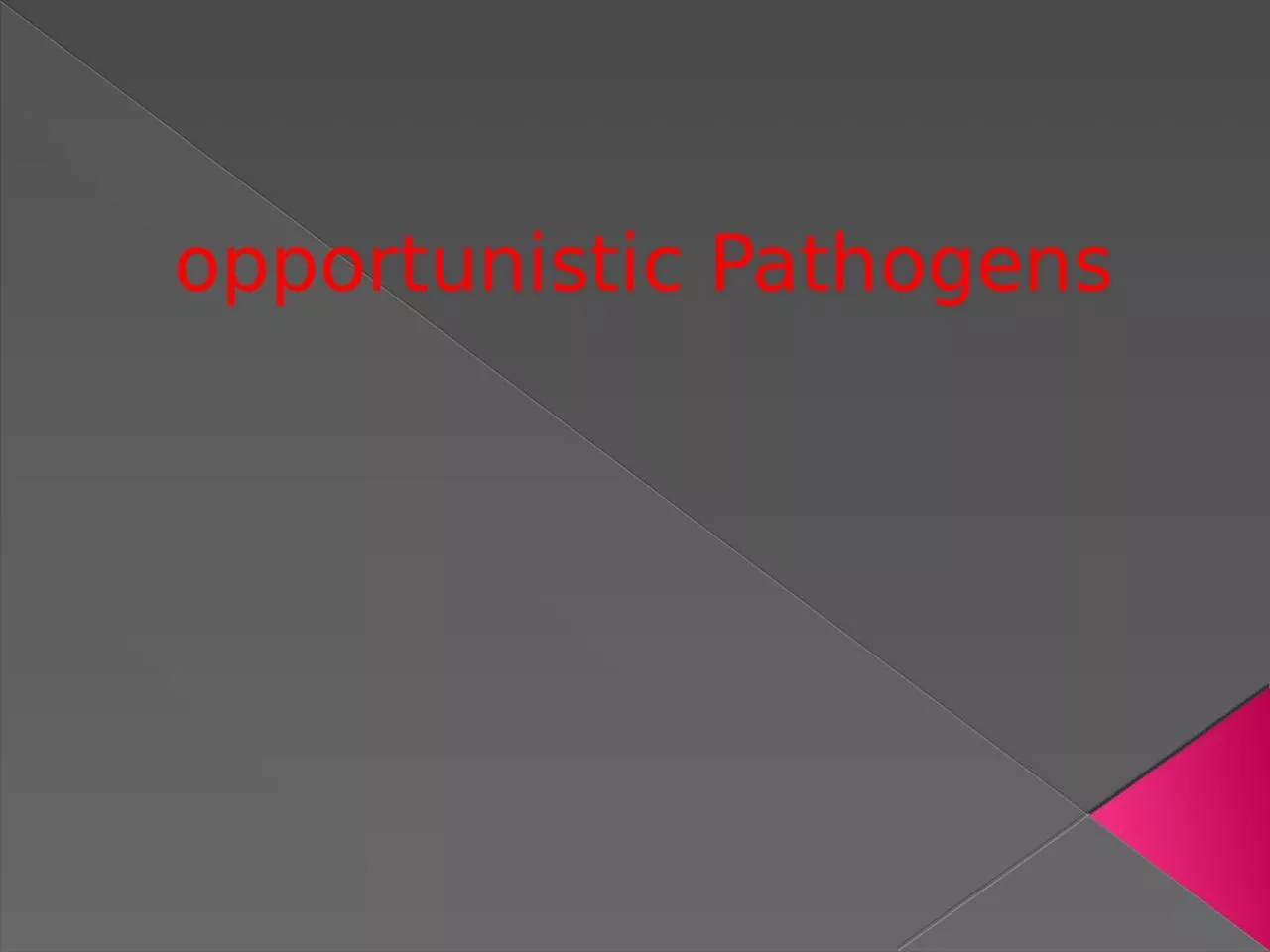

Cryptococcus neoformans Candida albicans Aspergillusspecies Pneumocystis carinii Cryptococcus neoformans Cryptococcus neoformans is a fungus that lives in the environment throughout the world People can become infected with C ID: 1041387
Download Presentation The PPT/PDF document "opportunistic Pathogens • opportunisti..." is the property of its rightful owner. Permission is granted to download and print the materials on this web site for personal, non-commercial use only, and to display it on your personal computer provided you do not modify the materials and that you retain all copyright notices contained in the materials. By downloading content from our website, you accept the terms of this agreement.
1. opportunistic Pathogens
2. • opportunistic Pathogens–Cryptococcus neoformans–Candida albicans–Aspergillusspecies–Pneumocystis carinii
3. Cryptococcus neoformans Cryptococcus neoformans is a fungus that lives in the environment throughout the world. People can become infected with C. neoformans after breathing in the microscopic fungus, although most people who are exposed to the fungus never get sick from it. C. neoformans infections are extremely rare in people who are otherwise healthy; most cases occur in people who have weakened immune systems, particularly those who have advanced HIV/AIDS
4. It has been isolated from various sources in nature especially with pigeon excreta. The fungus has also been isolated from the dung of caged birds including canarie sand parrots and Other environmental isolations of C. neoformans have been from rotting vegetables, fruits and fruit juices, wood, dairy products and soil.
5. Infection with the fungus Cryptococcus (either C. neoformans or C. gattii) is called cryptococcosis. Cryptococcosis usually affects the lungs or the central nervous system (the brain and spinal cord), but it can also affect other parts of the body. Brain infections due to the fungus Cryptococcus are called cryptococcal meningitis.
6. C. neoformans usually infects the lungs or the central nervous system (the brain and spinal cord), but it can also affect other parts of the body. The symptoms of the infection depend on the parts of the body that are affected.1-4 In the lungs A C. neoformans infection in the lungs can cause a pneumonia-like illness. The symptoms are often similar to those of many other illnesses, and can include: •Cough•Shortness of breath•Chest pain•Fever In the brain (cryptococcal meningitis) Headache, fever, and neck pain are common symptoms of cryptococcal meningitis. Cryptococcal meningitis is an infection caused by the fungus Cryptococcus after it spreads from the lungs to the brain. The symptoms of cryptococcal meningitis include: •Headache•Fever•Neck pain•Nausea and vomiting•Sensitivity to light•Confusion or changes in behavior
7. Cough is a common symptom of Cryptococcus infection in the lungsHeadache, fever, and neck pain are common symptoms of cryptococcal meningitis.
8. C. neoformans grows as a yeast (unicellular) and replicates by budding. It makes hyphae, and eventually creates basidiospores at the end of the hyphae before producing sporesDiagnosis
9. Culture: Colonies (SDA) cream-coloured smooth, mucoid yeast-like colonies. Microscopy: Globose to ovoid budding yeast-like cells. India Ink Preparation: Positive - Distinct, wide gelatinous capsules are present. Bird Seed Agar: Colonies turn dark brown in colour as colonies selectively absorb a brown pigment from this media (Staib, 1987). Creatinine dextrose bromothymol blue thymine (CDBT) agar:Cryptococcus neoformans grows as bright red colonies, turning the medium a bright orange after 5 days
10. Culture of C. neoformansIndia ink preparation showing capsules of C. neoformansBird seed agar plate showing brown colonies of C. neoformans and white colonies of Candida albicans
11. treatmentSystemic cryptococcosisrequires immediate treatment with amphotericin B and fluconazole over a period of weeks or months
12. Candida albicansSecondary Pathogens–Cryptococcus neoformans–Candida albicans–Aspergillusspecies–Pneumocystis carinii
13. Candida albicans Candida albicans is a dimorphic fungus, i.e. it can take two forms. Most of the time it exists as oval, single yeast cells, which reproduce by budding. Most yeasts do not produce mycelia (a mass of branching, threadlike hyphal filaments), In normal room temperatures the organism found in yeast form, but under physiological conditions (body temperature, pH, and the presence of serum) it may develop into a hyphal form. Pseudohyphae( composed of chains of cells) are also common.
14. CandidiasisCandidiasis is a fungal infection caused by yeasts that belong to the genus Candida. There are over 20 species of Candida yeasts that can cause infection in humans, the most common of which is Candida albicans. Candida yeasts normally live on the skin and mucous membranes without causing infection; however, overgrowth of these organisms can cause symptoms to develop. Symptoms of candidiasis vary depending on the area of the body that is infected. Candidiasis that develops in the mouth or throat is called “thrush” or oropharyngeal candidiasis. Candidiasis in the vagina is commonly referred to as a “yeast infection.” Invasive candidiasis occurs when Candida species enter the bloodstream and spread throughout the body.
15. Diagnosis of CandidiasisDirect Microscopy: (a) Skin and nails should be examined using 10% KOH and Parker ink or calcofluor white mounts; (b) Exudates and body fluids should be centrifuged and the sediment examined using either 10% KOH and Parker ink or calcofluor white mounts and/or gram stained smears; (c) Tissue sections should be stained using PAS digest, or Gram stainExamine specimens for the presence of small, round to oval, thin-walled, clusters of budding yeast cells (blastoconidia) and branching pseudohyphae
16. On Sabouraud's dextrose agar colonies are white to cream colored, smooth, glabrous and yeast-like in appearance.Microscopic morphology shows spherical to subspherical budding yeast-like cells or blastoconidia
17. 10% KOH mount showing the presence of budding yeast cells and pseudohyphae in a skin scrapingPAS stained smear showing the presence of budding yeast cells and pseudohyphae